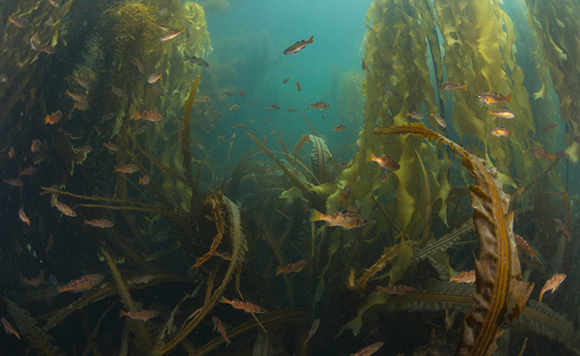by Tina Kelly – Shaw Centre for the Salish Sea –
They say life is all about balance. When it comes to life in kelp forests – and other natural systems – no truer words could be spoken. Human actions regularly upset these natural balances and in the case of some kelp forests, the imbalance has been more than a 100 years in the making.
Urchins are a significant prey item for sea otters and kelp is a main food source for urchins. Removing one link in this three-species food chain has caused an ecological shift scientists are now trying to reverse. In the 1800s, British Columbia’s fur trade was booming. Sea otters were plentiful and their fur was luxurious and lucrative. By 1929, otters were extirpated from the B.C. coast.
In the absence of a voracious predator – sea otters – the population of urchins exploded. These urchins grazed and grazed, leaving large expanses devoid of kelp. A land comparison familiar to many locals involves deer; in the absence of predators, deer numbers increase and vegetation is overgrazed. Scientists coined the term urchin barren to reflect an underwater landscape that has had most, if not all, kelp removed by urchins. With dwindling kelp forests comes the loss of critical habitat for many species including herring, salmon, rockfish and abalone. The latter two are considered threatened and endangered, respectively. While healthy kelp forests thrive with biological life, they also play a role in geological processes: kelp forests protect shorelines from erosion.
Gwaii Haanas National Park Reserve, National Marine Conservation Area Reserve, and Haida Heritage Site and the Haida Nation aim to reset the ecological balance that existed before otters were extirpated from the coast. In December, Parks Canada Ecologist Dr. Lynn Lee presented their efforts to an enthusiastic crowd at the Shaw Centre for the Salish Sea’s Floating Ideas Lecture Series. The project “Chiixuu Tll iinasdll (Nurturing Seafood to Grow)” represents one of the first ecosystem restoration projects in Canada where an Indigenous group, federal government and the commercial fishing sector are collaborating to achieve conservation goals.
Between 2017 and 2019, divers played the role of sea otter at the study site on Murchison Island. Seventy-five percent of urchins, or guuding.ngaay to the Haida people, were removed along three kilometres of the island’s shoreline. Many of these urchins were provided to Haida Gwaii communities while others were cracked or crushed and left underwater to feed microbes, fish and invertebrates, recycling nutrients back into the ecosystem.
With urchin numbers reduced kelp had an opportunity to re-establish into a forest and the complex ecological balance could return. And return it has. Prior to this project, scientists described the kelp at Murchison Island as existing in a narrow fringe below the low tide line. Fast forward to today and individual kelp number in the thousands and cover an area the size of nine soccer fields.
With the return of kelp forests comes more – more fish, more invertebrates, more diversity. And with the success of this project comes the knowledge to help inform conversations about continuing restoration in Haida Gwaii or elsewhere on the BC coast.
While this project lays outside the Salish Sea boundaries, the Salish Sea is also home to this critical ecosystem.
Visit the Shaw Centre for the Salish Sea’s kelp forest daily 10 a.m. to 4:30 p.m. (last admission at 4 p.m.).
Photo courtesy Ryan Miller.




